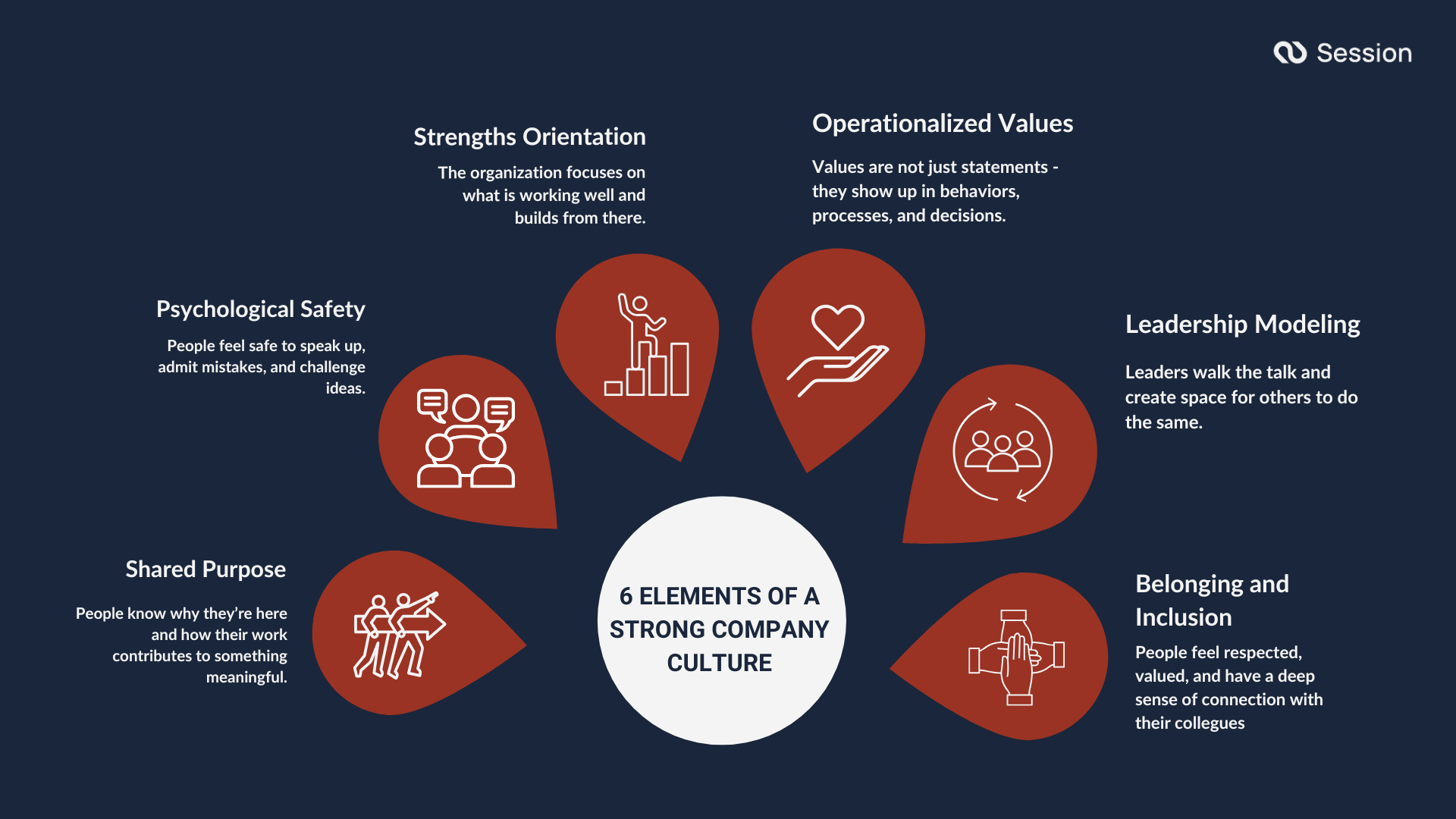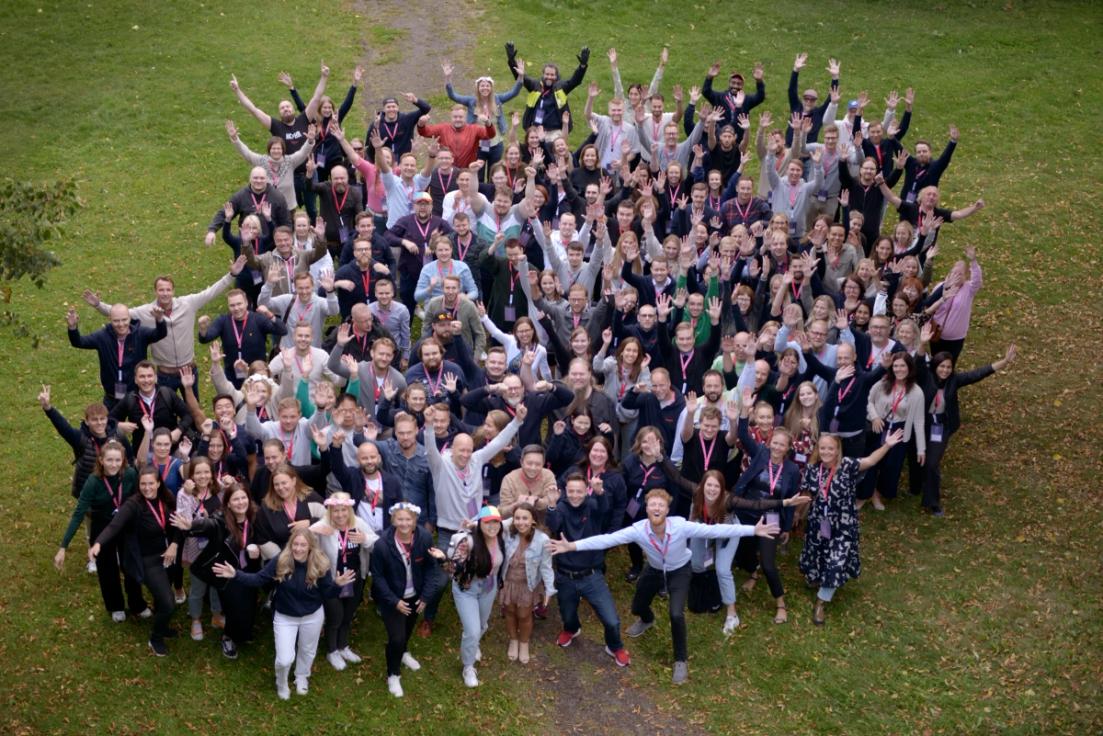What is company culture, really? Is it the mission statement on the wall? The perks in the employee handbook? Or perhaps the quarterly all-hands with motivational slides?
Someone once quipped, "Company culture is what people do when no one is looking." Another said: "Company culture is what people around here do - every day."
These informal definitions, often attributed to variations of Peter Drucker or Herb Kelleher, point to a simple truth: Culture isn’t what you say - it’s what you do. And more importantly, it’s what people experience, consciously and unconsciously, through actions, decisions, conversations, and behaviors - every day.
At Session, we take a strengths-based perspective on company culture. This means we start from what’s already working - building on the energy, habits, and values that give the company life. From there, culture becomes something you can shape deliberately, rather than leaving it to chance.
Why Does Company Culture Matter?
The phrase "Culture eats strategy for breakfast," often attributed to Peter Drucker (though it’s likely apocryphal), speaks to an essential truth: You can have the best-laid plans in the world, but if the culture doesn’t support execution, the strategy will fail.
That said, it’s not an either/or. Culture and strategy need to work together. Culture is the soil in which your strategic initiatives either take root or wither. A strong culture enables alignment, speeds up decision-making, reduces friction, and enhances commitment. It also serves as a buffer during times of crisis, giving people a sense of stability.
Nurturing a great company culture also matters because there is a deep connection between a great company culture and the human need to belong. As a human species we need to feel like we belong in order to perform well and go the extra mile for the company. When people feel like they belong, they’re more likely to:
- Share ideas and challenge norms
- Stay with the company longer
- Perform better
- Advocate for the organization
Belonging is an emotional state, but it’s driven by concrete factors: inclusion in decision-making, recognition of strengths, fair treatment, and shared purpose.
How Do You Grasp Company Culture?
You can’t manage what you don’t see, and culture can be frustratingly intangible. But there are ways to make it visible. Ask yourself:
- What do people praise and celebrate?
- What is rewarded and how do people get promoted?
- What do people tolerate - and what don’t they?
- How do people behave under pressure?
- Who gets listened to, and how?
- How are decisions made, and who gets to make them?
The answers to these questions are not just reflections of individual behavior - they’re clues to the underlying values, power structures, norms, and emotional climate that make up your company’s culture.
Nurturing the Culture You Want
Culture isn’t built in a single workshop or offsite. It’s something that grows through repeated actions over time. Here are three steps relevant to start with to nurture the culture you would like to see more of:
1. Identify Strengths in Existing Company Culture:
Start by mapping out what already works well in your organization and what part of your culture you would like to sustain.
2. Make Values Operational:
Identifying company values is only half the work. The key is translating them into daily practices, language, hiring decisions, performance reviews, and rituals.
3. Model and Embed Great Leadership Behavior:
Culture is caught more than taught. Leaders need to model the behavior we want to see. Over time, these behaviors become embedded in the organization’s DNA. If leaders have had no leadership training whatsoever, or never been through proper 360 evaluations, they might very well not behave in the most ideal or proper way in the day-to-day business.
Markers of a Healthy Culture
How do you know you’re on the right track with nurturing the right company culture for your company? Here are a few indicators:
- High levels of trust and psychological safety - creates the ability for people to speak up on relevant and urgent matters
- Consistency between words and actions - creates authenticity and reliability
- A sense of purpose felt across roles and departments - creates engagement and buy-in
- Open, respectful communication - even when there’s disagreement - creates safety for a mentally healthy culture where high performance can exist
- Pride in being part of the organization - attracts new employees through magnetism
- Surveys - showing that you are on the right track - gives you the relevant insight to know what is (really) at stake

Culture doesn’t have to be perfect to be healthy. In fact, acknowledging and addressing tensions or cultural drift is a sign that your culture is resilient.
4 types of Company Culture
When we talk about company culture, four primary types consistently emerge. These are based on the Competing Values Framework (CVF), a widely recognized model developed by Robert E. Quinn and Kim S. Cameron from the University of Michigan.
Their research identified two core dimensions that define organizational effectiveness:
- Internal Focus & Integration vs. External Focus & Differentiation
- Flexibility & Discretion vs. Stability & Control
These polarities form the basis for the four distinct culture types: Clan, Adhocracy, Market, and Hierarchy. Each offers a unique insight into how an organization operates, leads, and thrives. Let’s take a brief look at them in the following - and while you read through the markers of them - notice if you recognize your own company culture in any of them!
1. Clan Culture (Collaborate Culture)
- Characteristics: This culture is characterized by a friendly atmosphere. It emphasizes collaboration, teamwork, communication, and a strong sense of belonging. Leaders are often seen as mentors or facilitators. Loyalty and tradition are highly valued.
- Focus: Internal focus and high flexibility.
- Strengths: High employee engagement, strong morale, teamwork, open communication, employee development, and well-being.
- Weaknesses: Slow(er) decision-making in highly competitive environments, potential for "groupthink", and may be difficult to scale as the organization grows.
- Metaphor: A Clan / Tribe
2. Adhocracy Culture (Create Culture)
- Characteristics: This is a dynamic, entrepreneurial, and creative culture. It thrives on innovation, risk-taking, and rapid adaptation. The structure is often flat and decentralized, with individuals empowered to experiment and initiate change.
- Focus: External focus and high flexibility.
- Strengths: High innovation, quick adaptability, agility, encourages experimentation, attracts ambitious and creative talent.
- Weaknesses: Can lack stability, may be chaotic without clear direction, potential for burnout due to constant change, and can be challenging to maintain as the company grows.
- Metaphor: A Startup / Laboratory.
3. Market Culture (Compete Culture)
- Characteristics: This culture is results-oriented and competitive. It focuses intensely on external outcomes like market share, profitability, and outperforming competitors. Leaders are often tough, demanding, and drive performance through targets and incentives.
- Focus: External focus and high stability/control.
- Strengths: Strong focus on achieving measurable results, high productivity, competitiveness, customer orientation, and efficiency.
- Weaknesses: Can lead to high stress and employee burnout, lower employee loyalty, internal competition hindering collaboration, and neglect of employee well-being.
- Metaphor: An Army / Sports Team
4. Hierarchy/Top-down Culture (Control Culture)
- Characteristics: This is a structured, formalized, and control-oriented culture. It emphasizes stability, efficiency, clear processes, rules, and a well-defined chain of command. Decision-making is typically top-down.
- Focus: Internal focus and high stability/control.
- Strengths: Clear roles and responsibilities, efficiency, stability, predictability, effective risk management, and consistent processes.
- Weaknesses: Can be slow to adapt to change, may stifle innovation and creativity, potential for bureaucracy, and lower employee engagement due to less autonomy.
- Metaphor: A well-oiled Machine / Government agency.
It's important to remember that most organizations are a blend of these cultures, with one often being dominant. Understanding these types helps in analyzing an organization's current culture and strategizing for desired cultural shifts.
Culture in a Hybrid or Remote Setting
As we explored in a Session article on sustaining culture remotely, it is possible to nurture a vibrant culture in a remote or hybrid environment - but it requires intention.
Some practices we’ve seen work:
- Deliberate onboarding: Culture should be a part of how people are welcomed into the organization. Don’t leave it to chance.
- Regular rituals: Whether it’s a weekly check-in, virtual coffee, or gratitude round at the end of a meeting, rituals help reinforce values.
- Communication hygiene: Clarity, tone, responsiveness, and transparency matter even more when you’re not sharing physical space.
- Tools that reflect culture: Choose tools and platforms that make it easy to collaborate, share, and learn from each other.
- Leadership presence: Visibility of leaders - through async updates, office hours, or short videos - helps people feel connected.
The key is not to replicate office culture virtually, but to reimagine it in ways that work for a distributed team.
Summing it all up:
A healthy company culture isn’t static - it’s alive, evolving with your people, challenges, and context. But when nurtured intentionally, it becomes a powerful engine for trust, learning, collaboration, and performance. And in today’s world of uncertainty and constant change, that might just be your most sustainable advantage.












